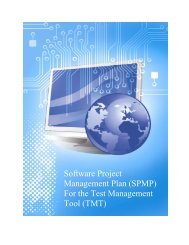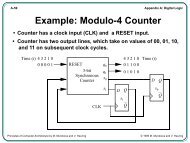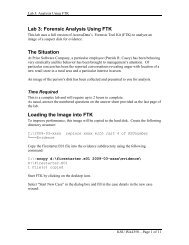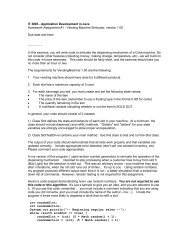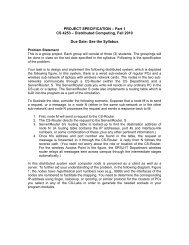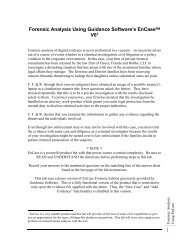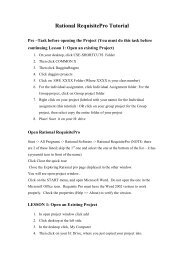Create successful ePaper yourself
Turn your PDF publications into a flip-book with our unique Google optimized e-Paper software.
9.1 Running on Windows<br />
DRAFT, February 18, 2003, Page 74<br />
The bin\<strong>jgrasp</strong>.exe file will start jGRASP in single-instance mode. Running jGRASP a second time will<br />
pop up the currently running instance. If you chose to associate file extensions with jGRASP during<br />
installation, clicking on an associated file will pop up the file in the currently running instance. A Windows<br />
application titled "jGRASP Control Shell", which initially runs minimized, displays the jGRASP output<br />
(including stack dumps if there is a crash) and allows the user to kill jGRASP if it locks up. It will first try a<br />
"soft kill", and if jGRASP does not exit within a few seconds, a "hard kill" will be issued.<br />
"bin\<strong>jgrasp</strong>.exe" will search for a java.exe to run jGRASP in the following manner:<br />
1) get from "-a" command line parameter if present<br />
2) get from JGRASP_JAVA environment variable if present<br />
3) check the PATH for javac.exe - if found look for java.exe in the same place (avoids finding JRE<br />
before JDK)<br />
4) check the PATH for java.exe - if it is found in the system directory, Windows directory, or any<br />
subdirectory of those, or if not found, check the registry for the distribution location of a Sun JDK<br />
installation.<br />
5) check for the JRE bundled with jGRASP<br />
The method used to find java.exe and the java command used to start jGRASP will be displayed in the<br />
"jGRASP Windows exec" window.<br />
9.2 Running on Mac OS X<br />
Double clicking on the "jGRASP Control Shell" file, or on "<strong>jgrasp</strong>/bin/macosx/jGRASP Control Shell" if<br />
jGRASP was manually installed, will start jGRASP in single-instance mode. Running jGRASP a second<br />
time will pop up the currently running instance. Clicking on an associated file will pop up the file in the<br />
currently running instance. An application titled "jGRASP Control Shell", which initially runs minimized,<br />
displays the jGRASP output (including stack dumps if there is a crash) and the command used to start<br />
jGRASP, and allows the user to kill jGRASP if it locks up. It will first try a "soft kill", and if jGRASP does<br />
not exit within a few seconds, a "hard kill" will be issued.<br />
The first time you run jGRASP it will create a soft link to a startup shell in /usr/bin or $HOME/bin. Then in<br />
a terminal shell you can run "<strong>jgrasp</strong>" and open files in an already running jGRASP with "<strong>jgrasp</strong> filename".<br />
9.3 Running on Linux, Solaris, and other UNIX<br />
Similar single-instance mode executables exist for x86 Linux and SPARC Solaris. These can both be<br />
accessed through the bin/<strong>jgrasp</strong> shell script, which will also pass the location of the jGRASP installation to<br />
the correct executable so you don't have to. You can run the executables directly (they are in<br />
subdirectories of "bin" with obvious names) if you specify the location of the jGRASP installation through a<br />
JGRASP_HOME environment variable or "-j path" at the command line. A window titled "jGRASP exec",<br />
which initially runs minimized, allows the user to kill jGRASP if it locks up. It will first try a "soft kill", and if<br />
jGRASP does not exit within a few seconds, a "hard kill" will be issued.<br />
On other UNIX, bin/<strong>jgrasp</strong> should run jGRASP directly, without a single-instance shell. See Installing on<br />
Other Systems for information on compiling the native parts of jGRASP.<br />
For the "java" startup script, if the location of java is not specified through a "-a" command line parameter<br />
or JGRASP_JAVA environment variable, then "java" must be on the path.






